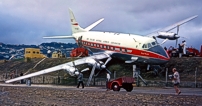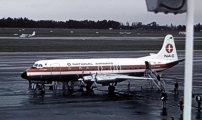
May 1961 to December 1975
New Zealand National Airways Corp (NAC)
ZK-BWO - c/n 428 - a V.807A series Viscount
New Zealand registered
10 November 1959
An order was announced by New Zealand National Airways Corporation (NAC) for their fourth Type 807A Viscount and also for four Fokker F27 Friendships.
The total order value was approximately £2,000,000.
10 May 1961
First flight from Hurn Airport, Bournemouth, Hampshire, England fitted with Rolls-Royce Dart RDa6 Mark 510 engines.
12 May 1961
Handed over to New Zealand National Airways Corporation (NAC) named as 'City of Dunedin' at Wisley Airfield, Surrey, England.
The aircraft was accepted by Hon. T McDonald who was the New Zealand High Commissioner.
19 May 1961
Departed on delivery to New Zealand National Airways Corporation (NAC).
The cabin seating was configured for 60 passengers.
29 May 1961
Arrived at Rongotai Airport, Wellington, New Zealand after the long delivery from the UK.
15 and 16 February 1963
Used as the Number 2 aircraft for the visit to New Zealand of Her Majesty Queen Elizabeth II and His Royal Highness The Duke of Edinburgh in support of ZK-BRE (C/N 282).
 1963 Royal visit crew operating instructions 1963 Royal visit crew operating instructions

Slid down an embankment
at Rongotai Airport, Wellington,
New Zealand
17 February 1963
After landing at Rongotai Airport, Wellington, New Zealand during a heavy rain storm the aircraft overran the runway and slid down an embankment onto Moa Point Road damaging the No.3 and No.4 propellers.
Some technical factors regarding this incident: -
On this particular day, the conditions at Wellington were unusual. There was heavy rain but the wind was light and variable. However, the crew was cleared for a landing to the South. The runway at Wellington has a marked slope from North to South.
The crew prepared for the landing during the descent from cruising altitude. They knew the exact weight of the aeroplane so the Target Threshold Speed (TTS) was calculated, allowing for any wind gusts or other factors. The TTS is the speed the pilot flying is aiming for at 50 feet above the runway threshold, at which point he will close the throttles, and aim to touch down at the 1,500ft markers on the runway. The flare is a matter of judgment based on the actual descent rate and the visually assessed height above the runway. If the flare is too early the aeroplane will start to float along the runway without touching down, and in the case of Wellington the slope of the runway simply makes matters worse, because there is also a factor called ground effect which is a cushion of air built up below the aircraft in calm conditions as pertained at this time.
It was up to the pilot in command to judge if a landing was possible, or alternatively to make a go-around. One complicating factor in this incident was that the First Officer was flying the aeroplane, and he failed to take corrective action when instructed to do so by the Captain, namely, to abort the landing.
It was recovered without further damage with a large crowd gathering to watch, as the incident occurred on a Sunday.
There were no injuries to the 37 passengers and 4 crew on board.
18 February 1963
Replacement propellers were flown from Christchurch inside a DC3 freighter with one blade of each propeller sticking out of a window position, which wasn't a problem as this type of aircraft was unpressurised.
20 February 1963
Ferried to Christchurch Airport, New Zealand for repairs.
Returned to service.

NAC
final Viscount livery
circa 1968
Painted in the NAC final Viscount livery.
28 September 1975
Withdrawn from service and stored at Christchurch International Airport, New Zealand.
10 October 1975
NAC Technical Records show that the following Rolls-Royce Dart RDa6 Mark 510 engines were in-situ on the aircraft: -
No.1 position S/N 5283. No.2 position S/N 5270, No.3 position S/N 5326, No.4 position S/N 5383.
12 December 1975
Export Certificate of Airworthiness (CofA) issued.
17 December 1975
Sold to Australian Aircraft Sales (AAS).
FURTHER READING
The Illustrated history of New Zealand National Airways Corporation
by Richard Waugh, Peter Layne and Graeme McConnell
 The Illustrated history of New Zealand National Airways Corporation 1947 - 1978 The Illustrated history of New Zealand National Airways Corporation 1947 - 1978
The delivery of New Zealand’s first Viscount by Peter Layne
 The delivery of New Zealand’s first Viscount The delivery of New Zealand’s first Viscount
|



